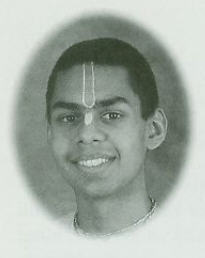
Ravi Gupta
ON THE FIRST OF January this year, at our ISKCON center in Boise, Idaho, we held a "japathon" an eight-hour session of japa (chanting the Hare Krsna mantra on beads). It was a spiritually rejuvenating way to begin the New Year, and many in our mostly Indian congregation took part wholeheartedly. Some chanters completed seventy-four rounds, while others did sixty-four, fifty, thirty-two, sixteen, or just a few.
Chintu Mudumbi, a fifteen-year-old who chanted seventy rounds, said of his experience, "When you chant like this, you realize that chanting actually works. All doubts about the reality of spiritual existence just go away. You begin to wonder why anyone would not take to the process."
Many other participants had similar thoughts. They felt the great power and pleasure in the holy name of Krsna.
In India today japa is somewhat of a lost practice. Among a great variety of religious activities people perform, japa is almost always absent. Religious speakers promote many ways to express our devotion to God, but rarely does one hear the glories of the personal chanting of the holy names. Japa chanters are mostly devoted widows or renounced sadhus living in places of pilgrimage.
Chanting on japa beads can be embarrassing for some people. For example, when I was visiting India my aunt remarked, "You don't realize if I went outside the house with japa beads in my hand, people would laugh at me and think I'd left the world to become a saint."
Even Indians who perform other spiritual practices find it difficult to get themselves to chant japa.
"I can sing or listen to hours of bhajanas [devotional songs]," said an Indian guest at the temple. "I can cook a feast for the Deities or read scripture but I just cannot sit down and do japa."
Yet japa is an important part of our heritage, and the Vedic scriptures extol its virtues. Srila Haridasa Thakura, an associate of Lord Caitanya, chanted 300,000 holy names every day. He is callednamacarya, "the teacher of the holy name." Sri Caitanya Mahaprabhu, who is Krsna Himself, also chanted a fixed number of rounds every day. King Kulasekhara, one of the great South Indian Alvars, writes in his Mukunda-mala-stotra, jihve sri-krsna-mantram japa japa satatam: "O tongue, please constantly chant the mantra composed of Sri Krsna's names." And in the Bhagavad-gita Lord Krsna says that of all sacrifices He is japa.
While all types of devotional service should ideally be done with full concentration on Krsna, we often derive secondary benefits from them, even when we're distracted. For example, we might listen tobhajanas for the pleasing music, cook prasadam to fulfill the family's needs, or read scripture out of intellectual curiosity. But chanting japa without focusing the mind on the holy names tends not to give secondary benefits. So it is a test of our purity, sincerity, and absorption in Krsna consciousness.
We have to work toward pure chanting, which will gradually bring us to the stage of ecstatic love of God. We have to carefully avoid offending the holy name. In the Srimad-Bhagavatam, Sukadeva Gosvami tells Maharaja Pariksit, "If one's heart does not change, tears do not flow from his eyes, his body does not shiver, nor his hairs stand on end as he chants the Hare Krsna maha-mantra, it should be understood that his heart is as hard as iron. This is due to his offenses at the lotus feet of the Lord's holy name."
Srila Prabhupada required his disciples to chant at least sixteen rounds of the Hare Krsna maha-mantra every day. That would help them progress in the pure chanting of the holy names. Prabhupada writes, "This chanting of sixteen rounds is absolutely necessary if one wants to remember Krsna and not forget Him. Of all the regulative principles, the spiritual master's order to chant at least sixteen rounds is most essential."
So let us pick up our japa beads and chant in earnest Hare Krsna, Hare Krsna, Krsna Krsna, Hare Hare/ Hare Rama, Hare Rama, Rama Rama, Hare Hare.
Ravi Gupta, age sixteen, lives at the Hare Krsna center in Boise, Idaho, USA. The center is run by his parents. Ravi, who was schooled at home, is a fourth-year student at Boise State University.
